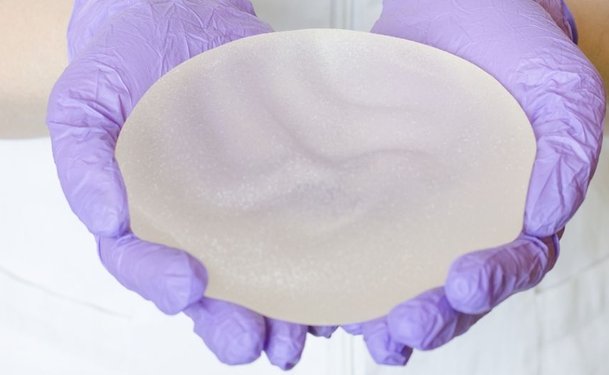As you research breast implants in preparation for your augmentation, you’ll find that there are two materials implants are made of: silicone gel or saline. In this article, we’ll discuss many points you should know about silicone implants so you can make a decision on if they’re the right for you.
What are cohesive silicone breast implants?
Silicone implants are made of an elastic silicone shell that is pre-filled with a silicone gel. The latest version of silicone implants, known medically as cohesive gel silicone implants, consist of a formulation that is more akin to a pliable solid than a liquid. This newer consistency gives the implants a firmer feel and makes them less likely to wrinkle or rupture once in the body.
Reputable manufacturing companies of implants, such as Mentor or Allergan, use a medical grade silicone that is proven to be safe in the body. In fact, silicone is used in many medical devices that are implanted into the body, including pacemakers and artificial joints.
Patients often refer to medically cohesive gel silicone implants and gummy bear implants (also known as form-stable implants) interchangeably. However, gummy bear implants are not the same formulation as a standard silicone implant and should be considered as a separate option. When cut in half, gummy bear implants hold together just as their namesake candy would. They have been developed to address the concern of leaking, and are known for their anti-gravity nature due to their dense consistency.
What makes cohesive silicone breast implants different?
Silicone gel breast implants can be non-form stable or form stable. What this means is that the non-form stable implant will not maintain its shape like that of a form stable implant, especially in the upper portion. Cohesive silicone gel breast implants are considered form stable and are referred to as fifth generation implants because they've been able to overcome some of the pitfalls founds in non-stable implants, which, again, did not retain their shape as well. Because form stable implants maintain their shape more, they've been able to produce better results for patients. Non-form stable implants are considered fourth generation.
the distribution of fill is more controlled (form). If you cut a form stable implant in half, the gel is almost a semi-solid, the same is true if the shell were to be removed.
Controlling the distribution of fill allows the surgeon to control the distibution of fill within the breast. this helps shape the breast.
advantages:
- rupture rate is lower than previous generations
- reduced capsular contracture rates
- maintain shape over time, more consistency
- lower re-operation rates
What do cohesive silicone breast implants look like on the body?
Compared to saline implants, silicone implants tend to have a more anatomical shape. Their pliability means they settle into the body more naturally. However, if you are not looking for a more natural shape, you can still use silicone implants and just opt to have them placed higher on the body for upper pole fullness.
One thing to keep in mind, which your doctor will (or should) discuss with you, is how the implant will look on your body according to the amount of breast tissue you currently have and your body type. If you have a lot of breast tissue covering the implant, the end result may be the same no matter what type of implant you chose. However, if you have a low amount of body fat and a slim frame, a silicone implant will give you the most natural look.
What do cohesive silicone breast implants feel like?
Silicone breast implants have a supple feel to them, which is more similar to a natural breast than the feel of saline implants. Some describe it as a “soft tissue” feel, while saline implants may feel more like a water balloon. This natural feel makes silicone implants preferred by many, and their popularity has increased steadily ever since they were first introduced to the market over 50 years ago.
What sizing and fill volume is available?
Unlike saline implants, silicone implants are pre-filled with a set volume before they’re inserted into the body. Some view this as an advantage because the sizing is standard and predictable across the board. That said, they come in a wide variety of sizes and profiles, as well as surface texture options, so you can fully customize them to your body. If you choose to go with silicone implants, you will not be limited by the sizing availability.
What are the possible complications of cohesive silicone implants?
Many patients are concerned with leaks over time once the implants are inserted. This is a common concern, and it is one that should be on your radar if you choose to go with silicone implants. Because saline implants consist of a liquid, a leak or rupture will be apparent since the implant will likely deflate—the saline will be absorbed into the body and the breast’s appearance will therefore look altered.
When silicone implants rupture or leak, the silicone is not as easily absorbed into the body due to the capsule (scar tissue) surrounding it, and it may not be obvious there is something wrong based on appearances. This scenario is commonly referred to as a silent rupture. However, there may be warning signs, including breast tenderness, pain, numbing, tingling, or hard lumps.
If you have any of these symptoms after your augmentation, you should visit your doctor as soon as you can. Physical trauma, general wear over time, implant hardening (capsular contracture) or complications from other medical procedures may cause a rupture. To be on the safe side, you can schedule an MRI every other year to detect any possible problems. Still, keep in mind that no matter which type of implant you choose, the chances of rupture and/or leaking are very low.
Updated September 2016



